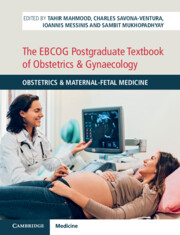Book contents
- The EBCOG Postgraduate Textbook of Obstetrics & Gynaecology
- The EBCOG Postgraduate Textbook of Obstetrics & Gynaecology
- Copyright page
- Dedication
- Contents
- Contributors
- Preface
- Section 1 Basic Sciences in Obstetrics
- Section 2 Early Pregnancy Problems
- Section 3 Fetal Medicine
- Section 4 Maternal Medicine
- Chapter 25 Hypertensive Disorders in Pregnancy and Eclampsia
- Chapter 26 Obesity and Metabolic Syndrome in Pregnancy
- Chapter 27 Screening for Gestational Diabetes Mellitus and Care of Diabetes Mellitus in Pregnancy
- Chapter 28 Cardiac Disease in Pregnancy
- Chapter 29 Respiratory Disease in Pregnancy
- Chapter 30 Thromboembolism in Pregnancy
- Chapter 31 Haemoglobinopathies in Pregnancy
- Chapter 32 Kidney Diseases in Pregnancy
- Chapter 33 Gastrointestinal Disorders in Pregnancy
- Chapter 34 Systemic Lupus Erythematosus and Pregnancy
- Chapter 35 Autoimmune Rheumatic Disorders in Pregnancy
- Chapter 36 Thyroid Disease in Pregnancy
- Chapter 37 Infections in Pregnancy
- Chapter 38 HIV Infection in Pregnancy
- Chapter 39 Acute Management of Sepsis in Pregnancy
- Chapter 40 Psychological Disorders in Pregnancy
- Chapter 41 Pregnancy after Solid Organ Transplantation
- Chapter 42 Oral Health and Periodontal Diseases in Pregnancy
- Section 5 Intrapartum Care
- Section 6 Neonatal Problems
- Section 7 Placenta
- Section 8 Public Health Issues in Obstetrics
- Section 9 Co-Morbidities during Pregnancy
- Index
- Plate Section (PDF Only)
- References
Chapter 25 - Hypertensive Disorders in Pregnancy and Eclampsia
from Section 4 - Maternal Medicine
Published online by Cambridge University Press: 20 November 2021
- The EBCOG Postgraduate Textbook of Obstetrics & Gynaecology
- The EBCOG Postgraduate Textbook of Obstetrics & Gynaecology
- Copyright page
- Dedication
- Contents
- Contributors
- Preface
- Section 1 Basic Sciences in Obstetrics
- Section 2 Early Pregnancy Problems
- Section 3 Fetal Medicine
- Section 4 Maternal Medicine
- Chapter 25 Hypertensive Disorders in Pregnancy and Eclampsia
- Chapter 26 Obesity and Metabolic Syndrome in Pregnancy
- Chapter 27 Screening for Gestational Diabetes Mellitus and Care of Diabetes Mellitus in Pregnancy
- Chapter 28 Cardiac Disease in Pregnancy
- Chapter 29 Respiratory Disease in Pregnancy
- Chapter 30 Thromboembolism in Pregnancy
- Chapter 31 Haemoglobinopathies in Pregnancy
- Chapter 32 Kidney Diseases in Pregnancy
- Chapter 33 Gastrointestinal Disorders in Pregnancy
- Chapter 34 Systemic Lupus Erythematosus and Pregnancy
- Chapter 35 Autoimmune Rheumatic Disorders in Pregnancy
- Chapter 36 Thyroid Disease in Pregnancy
- Chapter 37 Infections in Pregnancy
- Chapter 38 HIV Infection in Pregnancy
- Chapter 39 Acute Management of Sepsis in Pregnancy
- Chapter 40 Psychological Disorders in Pregnancy
- Chapter 41 Pregnancy after Solid Organ Transplantation
- Chapter 42 Oral Health and Periodontal Diseases in Pregnancy
- Section 5 Intrapartum Care
- Section 6 Neonatal Problems
- Section 7 Placenta
- Section 8 Public Health Issues in Obstetrics
- Section 9 Co-Morbidities during Pregnancy
- Index
- Plate Section (PDF Only)
- References
Summary
Hypertensive disorders of pregnancy (HDP) remain a major obstetric challenge across the world. No other antenatal complication is both so common and dangerous for the mother and baby together. Hypertension is the commonest medical problem encountered in pregnancy, and affects 10–15% of all pregnancies. Hypertension in pregnancy is divided into pre-existing hypertension (chronic hypertension), gestational hypertension (previously named pregnancy induced hypertension) and pre-eclampsia. Pre-eclampsia is the most severe HDP form, with great mortality and morbidity risk for the mother and offspring, especially in countries with inadequate antenatal care.
- Type
- Chapter
- Information
- The EBCOG Postgraduate Textbook of Obstetrics & GynaecologyObstetrics & Maternal-Fetal Medicine, pp. 201 - 212Publisher: Cambridge University PressPrint publication year: 2021

